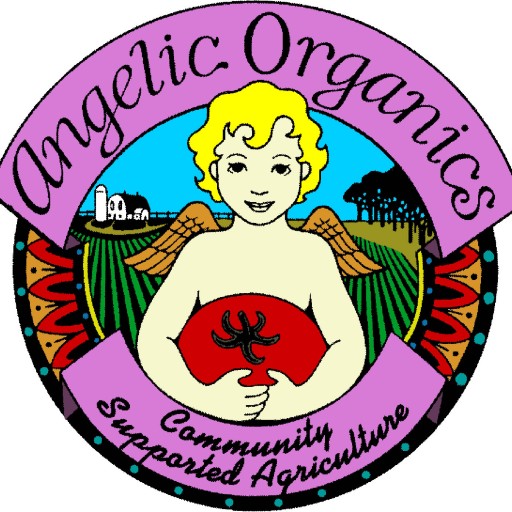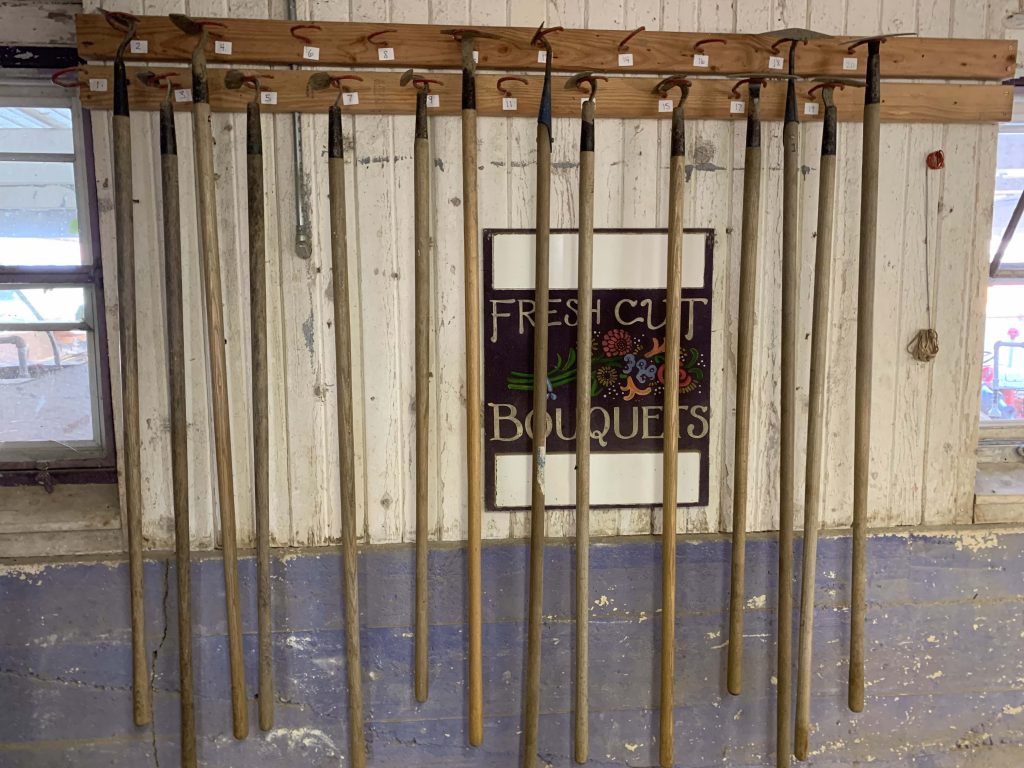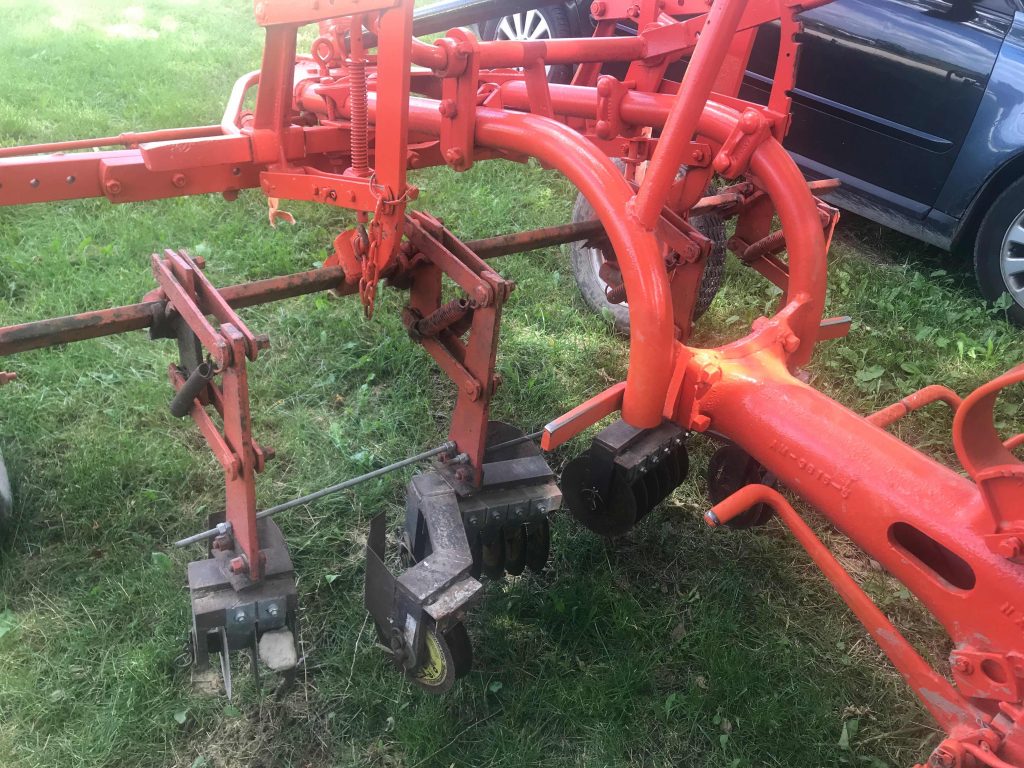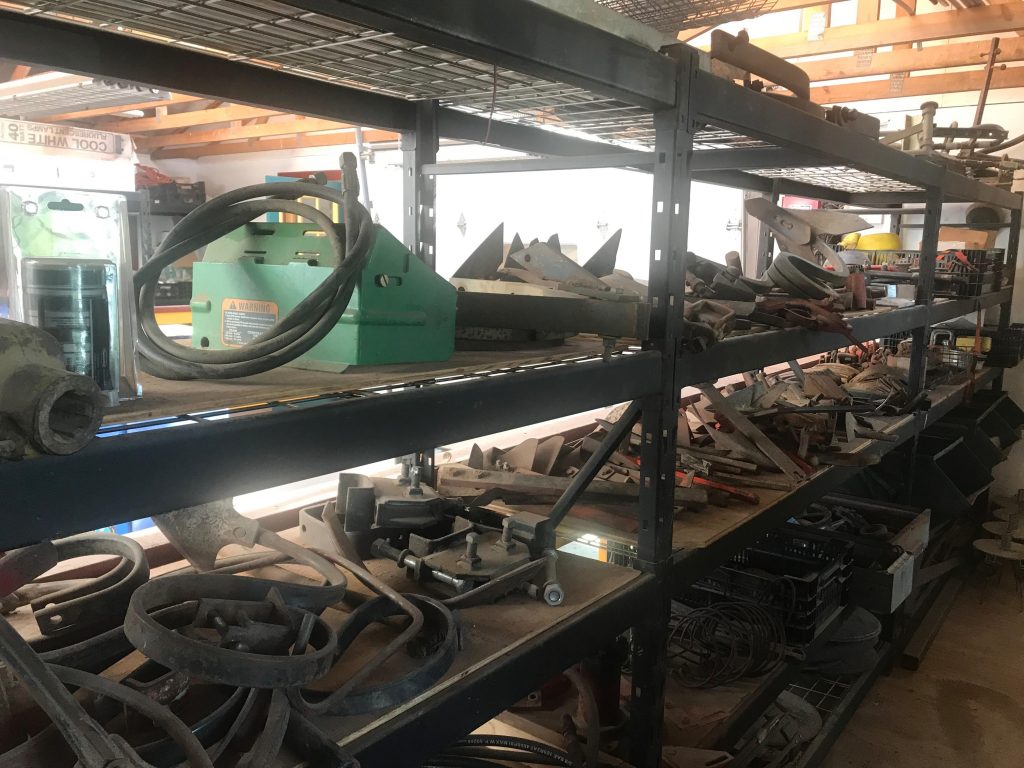Farmer John Writes: A Rogue Bank
Week 2, July 16th – 20th
Welcome
For some of you who receive a 10-week vegetable share and your deliveries start this week, welcome to our 2019 season. In case you missed Week 1 Farm News, check out When the Pavement Dries Fast.
A Hidden Account
There are many banks today. Most of them are registered and subject to stringent regulations.
Let me introduce you to the Weed Bank—rogue, unruly, unregulated (except by obscure laws of nature.) The weed bank is where weed seeds languish, sometimes for years, until conditions favor germination—foxtail seeds, for instance. Foxtail was a tremendous problem here in the early 90’s. It overran many of our crops. Gradually, we subdued it. It has not been a problem for 25 years, until recently. What has been happening to our soil that makes foxtail emerge from its dormant state after all these years?
I am writing this, dear shareholder, to give you a context as to why some crops are not available to you yet, like arugula. I am not writing to complain to you about weeds, even though I do feel anguish when I look upon weedy fields.
There are people who say that we should co-exist with the weeds. I, however, want to gaze at a field of vegetables and have it look immaculate, have it be about the vegetables in that field, not about a random distribution of weeds. You wouldn’t want to see random words in this essay, would you? They would jut out from the story, jar you and distract you from the story. Think of my fields as carefully edited stories.
Most people today think of cultivating crops as tending them, stewarding them. On farms, the term is more specific. Mechanical weeding is referred to as cultivating: cultivating crops is a way to get the crops to flourish by dispensing of the weeds.
For years, the policy on this farm has been weed free fields. We were quite successful for 20 years. We combined many methods for controlling the weeds: crop rotation, mechanical cultivation, tillage, hoeing, mowing, and, of course, hoeing. If a crop would be particularly prone to weeds, such as carrots, we would be especially intent on weeding that carrot field the year before, so as to empty the weed bank account of weed seeds in that upcoming carrot field. This would also apply to an upcoming field of baby greens like arugula. Year after year, we grew virtually weed free fields of arugula, mizuna, baby lettuce.
How did we get such weed free fields?
We weeded them thoroughly the year before, drawing down the account of weed seeds in the weed bank.

Early arugula this season; you can’t see a trace of arugula in this photo; foxtail and quickweed prevail
The arugula (that is supposed to be) in the photo above was seeded at 60 seeds per row foot, 9 rows per bed, rows 4 ½ inches apart. For every arugula seedling that emerged, I approximate between 20 and 50 weeds have emerged—foxtail and a new arrival, quickweed. Weeds cannot be managed in a crop like this. The crop simply has to be abandoned. (I recently seeded arugula in an alternative field with seemingly less weed pressure.)
What made all the foxtail emerge after 25 years of dormancy?
Is it due to the vibratory affects of rain relentlessly pounding the soil the last three years–more like smashing into the soil this year—a mosh pit of precipitation? “Wake up,” the rain rants. “You—hey you, foxtail—time to get up!”
Has the soil chemistry or biology changed with the persistent intrusion of moisture into our soil, which normally alternates between wetting and drying?
We have a plethora of weeding machines on the farm—4 rear mounted cultivators, 3 belly mounted cultivators, tine weeder, power wiggle hoe, hiller, wheel hoe. We have two small tractors completely dedicated to week control. On occasion, images of these weeding tools visit me in my sleep.
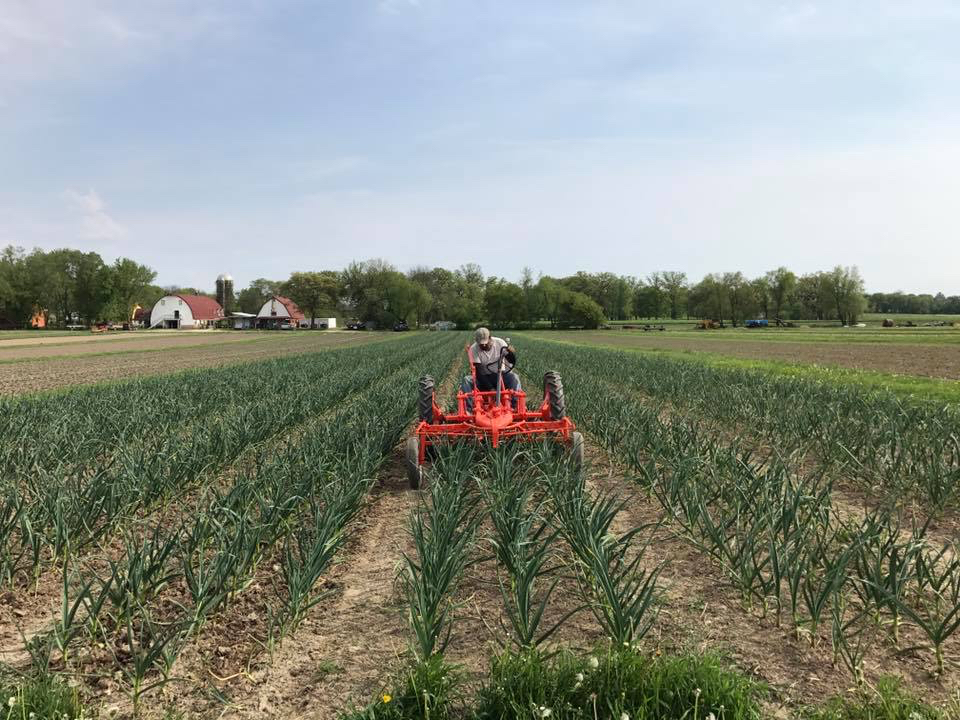
Eduardo cultivates garlic—weeds under control (this photo is from a previous season, this year’s garlic is further along than the garlic in this photo)
We have numerous options for how we equip our cultivators; we have points, sweeps, shanks, and tines in many different sizes and configurations. We have knives and side-knives. We have sweeps called goosefeet (or if you prefer, duckfeet.) We display all these weeding accessories in plain view on racks—need to find them in the moment, not look, not search, just find now. Weeds grow fast.
Eduardo, the farm cultivating expert, says things like, “the Hefty didn’t pull out the grass well enough. I’ll need to use the Allis G.”
“Yeah,” I say, “with the points. Those points are pretty good on grass.”
I set two fields aside to stale seedbed. To stale seedbed means to shallow till so as not to bring deeply buried weed seeds up to the surface—another form of weed control. It goes way back before chemical farming. Till those weeds! Then rain comes and more weeds germinate. Till those weeds again! Then rain and more weeds. Till again! Then rain and fewer weeds germinate sometimes. It depends on germination characteristics like whether they are weeds that emerge when the temperature reaches a certain level, or whether they only emerge according to day length. But sometimes, tilling certain varieties of weeds chops up their roots into little root chunks, each of which starts a weed offspring. An example of this reproductive feature can be found in purslane. Thistles, too.
The two fields that we are stale seedbedding seem like they are becoming less and less pressured by weeds. I have recently seeded arugula in one of these fields. Maybe we’ll have some nice arugula for you from this field later in the season.
(Do you know that arugula needs only 4 to 5 weeks from seeding to harvest?)
There are plenty of vegetables in our fields for your farm shares. The majority of the fields are not overwhelmed with weeds. We have our weeding accessories and our cultivating tractors to make sure of that. Besides the workings of nature, our methods for weed control also regulate the Weed Bank.
The Overflowing Farm Shares
We have never filled our boxes so full as we filled them the first week. Think of the surge of crops that were planted here, such as kale, chard, and scallions, with the plan of harvesting them for your shares much earlier in the season. Those crops went into the ground in a fairly timely way, but then the rains came and came and came, and planting the other crops was extensively delayed. This surge of early crops will even out, and your boxes will be less stuffed—still bountiful, I predict, but less stuffed.
Some Shareholder Preferences
It’s interesting to learn what shareholders want, vs what we guessed they wanted with our former packing system. For instance, 50% more shareholders prefer summer savory over anise hyssop. About as many shareholders prefer chard as prefer kale. Flat leaf parsley is more popular than curly parsley. About two thirds of our shareholders choose pea shoots for their share.
Didn’t Get What You Want?
In general, we are pleased with the Harvie customization system. For the most part, it has been easy for us to adapt to. The most challenging part of customizing your boxes is for our pack volunteers to read the small print on the labels. Most of our packers cannot read the label until the box on the conveyor belt is right upon them. I am working with Harvie to remedy this problem, as Harvie designed the label that we put on your box.
In the meantime, packing errors happen, because of all the energy that goes into reading the label vs actually putting the exact amount of the right item into the box. If your box is missing an item, let us know at email hidden; JavaScript is required.
Didn’t Get Your Box?
Several shareholders took random boxes from their pickup sites, not boxes with their names on them. Sometimes they noticed this later and returned the mistaken box to the site and got the right box; sometimes not. This problem will smooth out over time.
Emails
Please make sure to add both email hidden; JavaScript is required and email hidden; JavaScript is required to your email address book to make sure that you receive all pertinent emails.
Recipes
If you have been a shareholder with our farm before this season, you know that we offered a CSA recipe service called Local Thyme. Now that we have joined Harvie, and Harvie emails weekly recipes and cooking tips to shareholders, Local Thyme is no longer a part of your farm share subscription.
However, we love Local Thyme, and we want you to know that for $8.99 (reduced from $30) you can get a 1-year subscription to Local Thyme here and have access to a trove of fabulous recipes and cooking tips.
Please Fold Your Boxes Properly and Return Them
The farm re-uses the vegetable boxes. Flaps are easily torn when the boxes are dismantled improperly, and then the box bottom might later burst open with fresh, organic local produce heading towards the floor. Please carefully flatten your box and return it to your delivery site. If you receive home delivery, place your flattened, empty box it in the location where your box is delivered.
Thank You
Thank you to all our 2019 shareholders for being with us this season. Wherever you live, whatever you do, you are now a part of a farm. You are part of a place where wind, rain, soil, machinery, seed and people converge to grow your food.
Let us Know
Let the farm office know anything you’d like to share about this week’s box at email hidden; JavaScript is required. Please note the week and day of delivery, your site, when you picked up your box, and any comments about your box.
Warmly,
Farmer John
Angelic Organics Learning Center
Angelic Organics Learning Center is an exciting and engaging place to learn about food, farming, and caring for the earth. They even offer overnight programs. Sign up for a workshop at www.learngrowconnect.org/events

